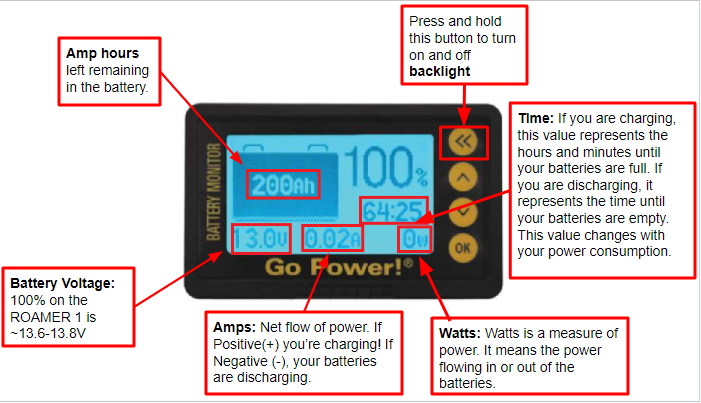Understanding the GoPower Battery Monitor
This article allows you a quick look at the battery monitor on the ROAMER 1. My purpose isn’t to take a deep dive into the electrical concepts associated with the GoPower Battery Monitor, but to allow a beginner to have some idea of what they are looking at and how it is relevant and important. This article isn’t a substitution for reading the manual or your own research into each of the concepts below! Click here to read the manual!
Sidenote: this same GoPower Battery Monitor is also featured in the X145 and the X195 by Imperial Outdoors.
Here at ROA Off-Road, we’ve come to really appreciate the folks over at GoPower and their products. We’ve been selling and working on trailers with GoPower products for quite some time now and we know their products give our ROAMERs an excellent and reliable experience with them. And if we ever have issues, we know that GoPower’s Customer Support Team will be there in our corner to help our technicians or our ROAMERs out with whatever they need.
Voltage on my GoPower Battery Monitor:
Volts is a measure of electrical force. I think about it as a measure of how hard the electricity is “pushing”. Imagine a big, heavy waterwheel sitting at the edge of a river that powers a grain mill. If the river doesn’t have enough force, the waterwheel won’t be able to turn as it should and the grain mill won’t function. When your batteries have low voltage, they don’t have enough force to make your appliances work and as a result lights will dim and fans will turn slow down. All you need to understand about Volts right now is that 100% on your batteries is approximately 13.6-13.8V and that your batteries will cut themselves off around 10.5V. The battery voltage is in the bottom left of the screen.
Amperage Vs Amp-Hours on my GoPower Battery Monitor:
Amps:
Amps (short for Amperage) is the flow of electricity. The higher the amps, the more electricity is flowing at once. You can find the Amps value to the right of the voltage at the bottom left of the screen. In the context of understanding your battery monitor, the amps here represent the net flow of power to or from your battery bank. Put simply, if you have a negative sign (-) by the amps, that means that you are using more power than you have coming in and the batteries are discharging. If you have a positive number it means the opposite. If you have a positive (+) sign by the amps, you have more power coming in that you are using in that moment. In other words, your batteries are charging.
I like to think of it as being similar to a checking account. If you have $1,000 in your bank account and every month you spend $200 and make $100, you have spent more than you have taken in and you have netted -$100. It is possible to do this with your ROAMER 1 trailer. It is possible to consume power faster than you are bringing it in.
Amp-Hours
Amp hours is a common measure of battery capacity. The name largely clarifies its definition. For example, a 100Amp-hour battery can expend 1 amp for 100 hours or 100 amps for 1 hour. While the math isn’t exactly so simple, the concept remains the same. On a basic level, this value conveys the same information as the percentage, providing insight into the battery’s overall remaining capacity.
Wattage on my GoPower Battery Monitor:
Watts is a measurement of power and Volts x Amps make up the formula. Watts in our context means Watts charging or Watts discharging. It tells you the rate at which you are charging or discharging depending on the sign next to the amps. If the sign next to the amp flow is negative, the watts value indicates power being drawn from the batteries. If the sign is positive, it signifies watts being used to charge the battery.

